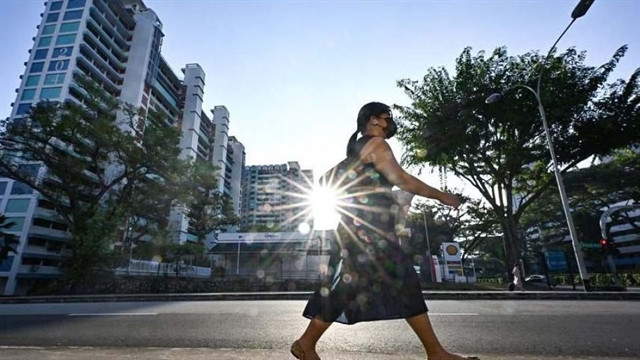How extreme heat affects the body and what you can do about it
Among the ways one could beat the heat is by heeding advisories, drinking lots of water, observing outdoor work precautions, and adapting to heat.
The searing heat of the sun and thick cloak of humidity have turned Singapore into an oven in recent days – but things could get more uncomfortable in the next couple of months.
The weatherman has warned that April and May, already among the hottest months of the year, could get even warmer due to the lingering impact of the El Nino phenomenon, which causes drier, hotter weather over South-east Asia. El Nino conditions have gripped Singapore since the second half of 2023, and while they are expected to taper off soon, experts have warned that the phenomenon is unlikely to fizzle out quietly.
Warmer temperatures, coupled with intense ultraviolet (UV) radiation from the sun on cloudless days, could well make the country feel like it is in an inferno.
With multiple studies showing how heat and glare can affect human health and well-being, The Straits Times breaks down the science behind the myriad of ways that the body responds to the rising mercury, and the tools available to beat the heat.
Body scan
1. Headaches
These can be caused by the sun’s glare and heat exhaustion.
Dehydration could also narrow blood vessels and shrink tissues in the brain and elsewhere. As the brain shrinks and pulls away from the skull, it causes headaches.
Prolonged heat triggers the body to lose the heat by sweating and dilating blood vessels in the skin. This can sometimes cause a fall in blood pressure and lead to headaches.
2. Heat cramps
Painful muscle spasms usually occur during physical exertion in hot weather.
The loss of fluids and salts contributes to the cramps, with the calves, arms and abdomen most affected.
3. Skin damage
Short-term exposure to intense UV rays can lead to sunburn, while long-term exposure raises the risk of skin cancer.
While the UV index can hit extreme levels on a hot day with less cloud cover, it is not linked to heat stress. UV levels can be just as high on a cool day with a clear sky.
4. Heat rash and eczema
In high humidity with moisture in the air, it is hard for sweat to evaporate.
Heat rash is due to sweat being trapped in the skin because of blocked or inflamed sweat ducts. It appears as small blisters and inflamed lumps.
Eczema flares up when excessive sweating further irritates the skin.
5. Kidney failure
Prolonged sweating causes fluids in the body to deplete, leading to severe dehydration.
Blood volume falls, putting strain on the kidneys and eventually causing renal failure.
Long-term exposure to heat stress and chronic dehydration may cause chronic kidney disease. This has been linked to agricultural labourers and outdoor workers in Latin America and India, for instance, as their kidney disease was not caused by known reasons such as diabetes and hypertension.
6. Reduced fertility
Prolonged exposure to daily average temperature exceeding 29.8 degree C can cause low sperm count and concentration, based on a recent study of Singapore men under Project HeatSafe, a study by the National University of Singapore.
The men had a 46 per cent higher risk of low sperm count, and a 40 per cent increased risk of low sperm concentration. The reproductive cells were also less motile and more sluggish.
These risks were more pronounced for men between the ages of 25 and 35, said the study.
Heat also affects women’s ovulation cycle and egg quality.
Risks of being under the weather
Heatstroke
This is the most serious heat illness and can be fatal. It occurs when the body can no longer control its core temperature, which can spike to 40 degree Celsius or higher.
A glimpse into how heatstroke progresses
Confusion, delirium and slurred speech are symptoms of heatstroke. (Point A in graphic)
Later, a leaky gut could manifest. The intestinal barrier breaks down, releasing toxins and bacteria into the bloodstream. (Point D)
Systemic inflammation could then occur. At this stage, the immune system responds too aggressively to infection. (Point B)
These processes could ultimately lead to multi-organ failure. (Point C)
Accidents and productivity
Heat and dehydration cause fatigue, irritability, lethargy and impaired judgment. They also affect coordination and concentration.
Heat syncope – a fainting episode caused by standing for too long in the heat – can cause workers to fall from heights. Blood pools in lower limbs and blood pressure falls.
In 2035, rising heat could cause a $2.22 billion loss in labour productivity in Singapore, across the construction, services, manufacturing and agriculture sectors, a study under Project HeatSafe has found.
Watching out for the vulnerable
Seniors
As the body tries to cool off by shifting blood flow from its core to the skin so that heat can dissipate, this takes a toll on seniors with heart disease, renal disorder and lung disease. Oxygen to the organs is reduced as the skin and the organs compete for blood.
Medications such as blood thinners, Alzheimer’s disease medication, and some chemotherapy drugs can affect the body’s ability to regulate temperature.
Young children
Babies and toddlers are unable to say that they feel hot or thirsty, and may lack the judgment to limit exertion in hot weather.
Heatstroke-related deaths in children commonly happen when they are trapped in parked cars. In just 20 minutes, a car parked outdoors can see its interior temperature rise to over 48 degree Celsius.
Beating the heat
Heed the advisory
Minimise outdoor activities and take more frequent breaks under the shade.
Keep hydrated.
Avoid wearing multiple layers of clothing.
Drink wisely
While hydration is vital, drinking too much can cause water intoxication, where blood sodium levels fall.
A warm or hot drink will make you sweat more, and if the sweat does not evaporate, it will lead to overheating.
Isotonic ice slushies work best. Studies have shown that the frosty drink is more effective in bringing down core body temperature than iced liquids, improving endurance performance.
Outdoor work precautions
Shift heavy labour to cooler parts of the day.
Take regular rest and water breaks in a shaded, ventilated area.
Install an alert system for high temperatures.
Monitor workers more vulnerable to heat injury.
Adapt to heat
Heat acclimatisation gradually exposes foreign workers and soldiers to the hot environment, enabling them to better tolerate heat.
Workers new to Singapore or returning from prolonged leave must be acclimatised over at least seven days.
Exercise
Doing more aerobic exercises, such as running and cardio workouts, will improve the body’s thermal capacity.
Such exercises will also train the heart to pump blood more efficiently.
First aid
If someone shows heat injury symptoms such as muscle cramp, nausea or disorientation:
Call for the ambulance.
Move the person to a shady place and try to cool him down with a wet cloth, ice pack or fan. Place the ice packs against the neck, armpits and groin. Loosen excess clothing.
If the person is conscious, give him cold water.






